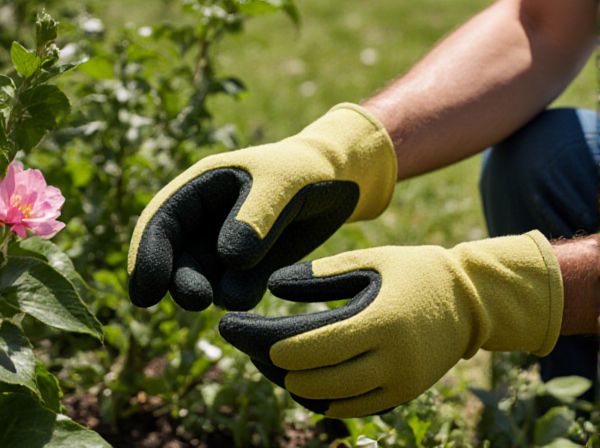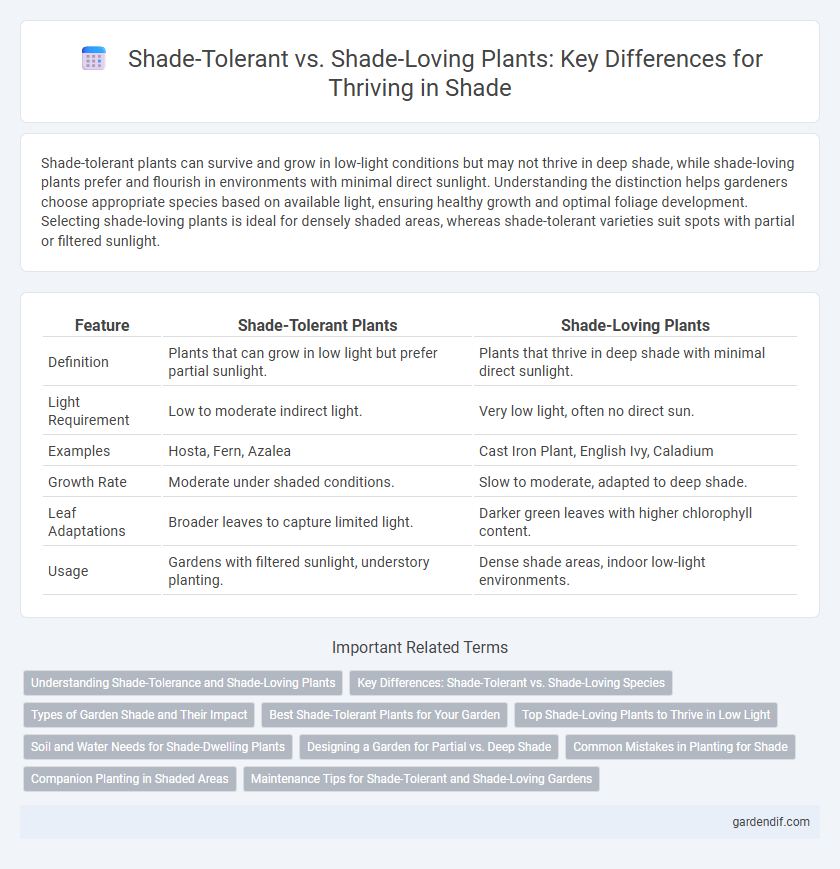
Shade-tolerant vs shade-loving Illustration
Shade-tolerant plants can survive and grow in low-light conditions but may not thrive in deep shade, while shade-loving plants prefer and flourish in environments with minimal direct sunlight. Understanding the distinction helps gardeners choose appropriate species based on available light, ensuring healthy growth and optimal foliage development. Selecting shade-loving plants is ideal for densely shaded areas, whereas shade-tolerant varieties suit spots with partial or filtered sunlight.
Table of Comparison
| Feature | Shade-Tolerant Plants | Shade-Loving Plants |
|---|---|---|
| Definition | Plants that can grow in low light but prefer partial sunlight. | Plants that thrive in deep shade with minimal direct sunlight. |
| Light Requirement | Low to moderate indirect light. | Very low light, often no direct sun. |
| Examples | Hosta, Fern, Azalea | Cast Iron Plant, English Ivy, Caladium |
| Growth Rate | Moderate under shaded conditions. | Slow to moderate, adapted to deep shade. |
| Leaf Adaptations | Broader leaves to capture limited light. | Darker green leaves with higher chlorophyll content. |
| Usage | Gardens with filtered sunlight, understory planting. | Dense shade areas, indoor low-light environments. |
Understanding Shade-Tolerance and Shade-Loving Plants
Shade-tolerant plants possess adaptations that enable them to survive and grow with limited sunlight, often thriving under tree canopies or in shaded garden areas. Shade-loving plants not only tolerate low light but actively prefer shaded environments, exhibiting optimal growth and vibrant foliage in these conditions. Understanding the distinctions between shade-tolerant and shade-loving species is essential for effective garden planning and maximizing plant health in low-light settings.
Key Differences: Shade-Tolerant vs. Shade-Loving Species
Shade-tolerant species possess physiological adaptations that allow them to survive and grow with minimal sunlight, often thriving under dense canopy cover, while shade-loving species prefer partial shade environments and may require more light for optimal growth. Shade-tolerant plants typically have larger chloroplasts and optimized leaf structures to capture limited light efficiently, whereas shade-loving plants exhibit moderate tolerance but perform best with filtered sunlight. Understanding these distinctions aids in selecting appropriate vegetation for landscaping and ecological restoration in low-light habitats.
Types of Garden Shade and Their Impact
Types of garden shade significantly influence the growth of shade-tolerant and shade-loving plants by determining light intensity and duration. Dense canopy shade from mature trees creates deep shade conditions favoring highly shade-tolerant species such as ferns and hostas, while dappled or filtered shade under smaller trees or shrubs supports shade-loving plants like impatiens and begonias. Understanding the specific shade type--full, partial, or dappled--enables gardeners to select plants best suited to their garden's microclimate, optimizing health and aesthetic appeal.
Best Shade-Tolerant Plants for Your Garden
Shade-tolerant plants thrive in low-light conditions by adapting their photosynthesis processes, making them ideal for areas with minimal sunlight. Popular shade-tolerant species include hostas, ferns, and astilbes, all known for their lush foliage and resilience in shaded garden spots. Selecting plants specifically categorized as shade-tolerant ensures vibrant growth and minimal maintenance in shaded garden environments.
Top Shade-Loving Plants to Thrive in Low Light
Shade-loving plants such as hostas, ferns, and astilbes thrive in low-light conditions by optimizing photosynthesis with minimal sunlight, making them ideal for shaded gardens and indoor spaces. These shade-tolerant species adapt to limited light by developing larger leaves and a slower growth rate, ensuring health and vibrancy despite reduced illumination. Incorporating top shade-loving plants enhances garden diversity and provides lush foliage where sunlight is scarce.
Soil and Water Needs for Shade-Dwelling Plants
Shade-tolerant plants adapt to low light by requiring well-drained, nutrient-rich soil with consistent moisture, while shade-loving plants thrive in soils with higher organic matter and retain moisture longer. Both types benefit from soil amended with compost to improve aeration and water retention, but shade-loving species require more frequent watering to counterbalance reduced photosynthesis rates. Proper soil pH and balanced irrigation schedules are critical to support healthy root development and prevent fungal diseases common in shaded, moist environments.
Designing a Garden for Partial vs. Deep Shade
Selecting shade-tolerant plants for a garden with partial shade ensures thriving growth where sunlight filters through tree canopies, supporting species like hostas and astilbes. Shade-loving plants, adapted for deep shade with minimal light, such as ferns and hellebores, require careful placement to maintain moisture and soil richness. Understanding the difference between partial and deep shade zones optimizes garden design by matching plant species to light availability, enhancing both health and aesthetic appeal.
Common Mistakes in Planting for Shade
Shade-tolerant plants can survive with minimal sunlight but often grow slowly or become leggy without adequate light, while shade-loving plants require consistently low light levels to thrive and may suffer from direct sun exposure. A common mistake is planting shade-tolerant species in deep shade without assessing the actual light intensity, leading to poor growth and compromised health. Another error occurs when gardeners confuse shade-loving plants with shade-tolerant ones, resulting in inappropriate placement that reduces plant vigor and increases susceptibility to disease.
Companion Planting in Shaded Areas
Shade-tolerant plants adapt to low light by having larger leaves and slower growth, making them ideal for companion planting in shaded garden areas where sunlight is limited. Shade-loving plants thrive exclusively in low light conditions, often supporting the growth of shade-tolerant species by creating microclimates that reduce moisture loss and soil erosion. Selecting compatible shade-tolerant and shade-loving plant combinations enhances biodiversity, improves soil health, and maximizes space efficiency in shaded garden environments.
Maintenance Tips for Shade-Tolerant and Shade-Loving Gardens
Shade-tolerant gardens require minimal watering and benefit from mulching to retain soil moisture, reducing stress on plants that thrive in low-light conditions like hostas and ferns. Shade-loving plants, such as impatiens and begonias, need regular pruning to promote airflow and prevent mold, along with periodic fertilization to support healthy growth in shaded environments. Both garden types perform best with soil enriched by organic matter and careful monitoring for pests adapted to damp, low-light habitats.
Shade-tolerant vs shade-loving Infographic

 gardendif.com
gardendif.com